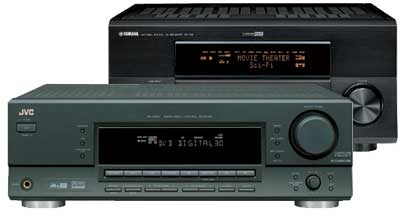How to Buy Surround Sound Page 6
A digital surround receiver is the heart of your home theater. Besides delivering power to all your speakers (except the subwoofer), it lets you switch between your DVD player and other source components, sends the video signal to your TV, and does the surround sound processing that turns your family room into a theater.  A basic receiver (front) puts out enough power for a small to medium-size room and provides a full complement of surround modes. Bigger, more expensive "flagship" receivers (rear) can be expected to supply enough power for larger rooms, be more rugged, and offer features like automatic surround sound setup.
A basic receiver (front) puts out enough power for a small to medium-size room and provides a full complement of surround modes. Bigger, more expensive "flagship" receivers (rear) can be expected to supply enough power for larger rooms, be more rugged, and offer features like automatic surround sound setup.
I'm happy to tell you that today's receivers offer far more features and even better performance than those of just a few years ago. Things like processing for surround sound playback of stereo programs and switching for high-definition video sources are available even in inexpensive models.
All home theater receivers decode the Dolby Digital 5.1 soundtracks found on virtually all DVDs, and most also decode DTS and a variety of other surround sound formats (see "Surround Formats"). Most now also offer 6.1- and 7.1-channel decoding and amplification as well.
How Much Power? It's important to know how much power you'll need per channel, and it depends on several factors, including the size and acoustic characteristics of your room, how loud you like your music and movies, and how efficient your speakers are, as indicated by their sensitivity rating. (A 3-dB increase in sensitivity means that you need half as much power to produce the same volume, while a 3-dB decrease in sensitivity means you need double the power requirement.) It takes less power to fill "live" rooms that have hard, reflective surfaces than it does "dead" ones that have lots of upholstered furniture and thick carpeting.
All things considered, you'll probably need less power than you think: 40 or 50 watts per channel is plenty for most music listening, and unless you have a really big or really dead room or unusually inefficient speakers, 80 to 100 watts per channel will make sure action-movie climaxes don't sound wimpy. Having more power on hand never hurts, but there's no good reason to use a receiver with more than 100 watts per channel in a compact bedroom system.
Ins and Outs Make sure you have enough audio and video inputs for all of your source components. Figure out how many sources you'll need to connect - and then allow for future additions to your system. Since you have to use the digital audio connections from your source components to get surround sound - except for DVD-Audio and Super Audio CD playback - make sure the receiver has enough digital audio inputs. (For DVD-Audio and SACD, you'll need a receiver with a multichannel analog audio input.) And make sure your receiver has HDTV-compatible component-video inputs so you can use it to switch between high-def sources.
You're going to be spending a lot of time with your receiver's remote control, so consider how easy it is to use. Most receiver remotes can also operate other components in your system, so be sure to ask the salesman about that. And make time while you're in the store to navigate the onscreen menus and operate basic receiver functions from the remote. If the remote feels awkward or seems too difficult to learn, you might want to consider a different receiver.
Beyond the Basics Today's receivers offer a tremendous variety of performance and convenience features. These include such goodies as digital signal processing (DSP) surround modes, extra outputs for speakers in a remote room (sometimes with independent control of the source and volume), and upconversion of composite- and S-video signals to component video, which means only one connection between the receiver and your TV. Some models even offer automated system setup so you don't have to balance channel levels yourself or work through menus of options for things like bass management.




























































